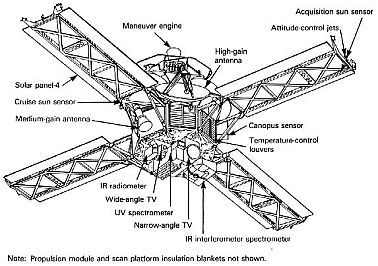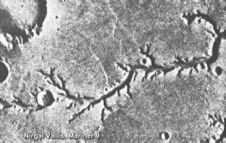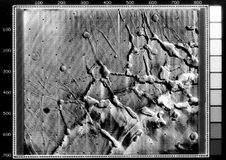Mariner 9
Mariner 9, an unmanned NASA spacecraft made many important discoveries about Mars. It was launched on May 30, 1971. Mariner 9 went into orbit about nine months later on November 14. [1] [2] It was the first spacecraft to orbit another planet.[3] During its mission, it returned about 100 times more information than all previous missions to Mars.[4]
Contents
Scientific instruments
The instruments aboard Mariner 9 were - Imaging system - Infrared radiometer - Ultraviolet spectrometer - Infrared interferometer spectrometer[5]
Instruments of Mariner 9
Accomplishments
Mariner 9 completely changed our conceptions about Mars. Mariner 4, the first spacecraft to send back close-up pictures of the planet, made us think that Mars was just like the Moon with a surface covered with nothing but craters. After a major dust storm cleared, Mariner 9 took pictures of 100 percent of the surface and revealed huge volcanoes and a giant canyon (3,000 miles long). In addition it discovered curved and branched river valleys. The spacecraft also provided the first close-up pictures of gigantic volcanoes and a grand canyon stretching 4,800 kilometers (3,000 miles) across its surface. Phobos and Deimos, the two small, irregular-shaped moons of Mars were seen up close.[6] When the mission was over in October 1972, Mariner 9 had taken 7329 images.[7]
Orbit Insertion
After arriving in the vicinity of Mars, Mariner 9 burned 99 pounds of fuel to get into orbit. It’s retrorocket applied nearly 300 pounds of thrust for 15 minutes and 15.6 seconds. The initial orbit was 1,385 Km to 17,300 km about the Martian surface. Later, the orbit was adjusted to have a range of 17,100 km to 1,650km with a period of 11.98 hours.[8]
References
- ↑ "Mariner 9: Trajectory Information". National Space Science Data Center. Retrieved December 28, 2011.
- ↑ Mariner Mars 1971 Project Final Report" (PDF). NASA Technical Reports Server. Retrieved December 28, 2011.
- ↑ https://www.space.com/18439-mariner-9.html
- ↑ Murray, B. 1973. Mars from Mariner 9. Scientific American. January, 49-69.
- ↑ https://www.jpl.nasa.gov/missions/mariner-9-mariner-i/
- ↑ https://mars.nasa.gov/programmissions/missions/past/mariner89/
- ↑ https://mars.jpl.nasa.gov/programmissions/missions/log/
- ↑ Murray, B. 1973. Mars from Mariner 9. Scientific American. January, 49-69.
See Also
External links
- [Mariner 9 Launches - 1971 | Today In History | 30 May 17]
- [[ https://www.youtube.com/watch?v=9a79p_Ff1sw Carl Sagan on the Mariner 9 Mars Orbiter: "The Search Begins" 1974 NASA-JPL]]









